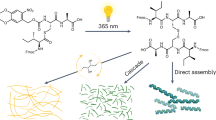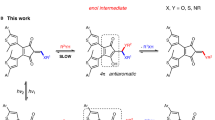Abstract
Stimuli-responsive behaviour is key to the design of smart materials, surfaces, nano-systems and effector molecules, allowing their application as switchable catalysts, molecular transporters, bioimaging probes or caged drugs. Supramolecular chemistry has embraced the widespread integration of photoswitches because of their precise spatiotemporal addressability and waste-free nature. In the vibrant area of discrete metal-mediated self-assembly, however, photoswitches are still rarely employed. Only recently has it been shown that embedding photoswitches into the organic backbones of coordination cages enables control of their host and material properties and thus unlocks the hitherto unexploited dynamic adaptivity of such systems. Here we discuss four cases where triggering ligand-integrated photoswitches leads to (1) control over disassembly/reassembly, (2) bi-stable switching between defined states, (3) interplay with thermal processes in metastable systems and (4) light-fuelled dissipative self-assembly. We highlight first clues concerning the relationship between fundamental photophysics and dynamic assembly equilibria and propose directions for future development.

This is a preview of subscription content, access via your institution
Access options
Access Nature and 54 other Nature Portfolio journals
Get Nature+, our best-value online-access subscription
$29.99 / 30 days
cancel any time
Subscribe to this journal
Receive 12 print issues and online access
$259.00 per year
only $21.58 per issue
Buy this article
- Purchase on Springer Link
- Instant access to full article PDF
Prices may be subject to local taxes which are calculated during checkout




Similar content being viewed by others
References
Volarić, J., Szymanski, W., Simeth, N. A. & Feringa, B. L. Molecular photoswitches in aqueous environments. Chem. Soc. Rev. 50, 12377–12449 (2021).
Baroncini, M., Silvi, S. & Credi, A. Photo- and redox-driven artificial molecular motors. Chem. Rev. 120, 200–268 (2020).
Chagri, S., Ng, D. Y. W. & Weil, T. Designing bioresponsive nanomaterials for intracellular self-assembly. Nat. Rev. Chem. 6, 320–338 (2022).
Takezawa, H., Shitozawa, K. & Fujita, M. Enhanced reactivity of twisted amides inside a molecular cage. Nat. Chem. 12, 574–578 (2020).
Cullen, W. et al. Catalysis in a cationic coordination cage using a cavity-bound guest and surface-bound anions: inhibition, activation and autocatalysis. J. Am. Chem. Soc. 140, 2821–2828 (2018).
Fang, Y. et al. Catalytic reactions within the cavity of coordination cages. Chem. Soc. Rev. 48, 4707–4730 (2019).
Lin, H.-Y., Wang, Y.-T., Shi, X., Yang, H.-B. & Xu, L. Switchable metallacycles and metallacages. Chem. Soc. Rev. 52, 1129–1154 (2023).
Wang, J.-X., Li, C. & Tian, H. Energy manipulation and metal-assisted photochromism in photochromic metal complex. Coord. Chem. Rev. 427, 213579 (2021).
Wezenberg, S. Light-switchable metal-organic cages. Chem. Lett. 49, 609–615 (2020).
Regeni, I. et al. Coal‐tar dye‐based coordination cages and helicates. Angew. Chem. Int. Ed. 60, 5673–5678 (2020).
Jiao, Y., Zuo, Y., Yang, H., Gao, X. & Duan, C. Photoresponse within dye-incorporated metal-organic architectures. Coordin. Chem. Rev. 430, 213648–213706 (2021).
Goeb, S. & Sallé, M. Electron-rich coordination receptors based on tetrathiafulvalene derivatives: controlling the host-guest binding. Acc. Chem. Res. 54, 1043–1055 (2021).
Cai, L.-X. et al. Water-soluble redox-active cage hosting polyoxometalates for selective desulfurization catalysis. J. Am. Chem. Soc. 140, 4869–4876 (2018).
Ngai, C., Sanchez‐Marsetti, C. M., Harman, W. H. & Hooley, R. J. Supramolecular catalysis of the oxa‐Pictet-Spengler reaction with an endohedrally functionalized self‐assembled cage complex. Angew. Chem. Int. Ed. 132, 23711–23715 (2020).
Whitehead, M., Turega, S., Stephenson, A., Hunter, C. A. & Ward, M. D. Quantification of solvent effects on molecular recognition in polyhedral coordination cage hosts. Chem. Sci. 4, 2744–2751 (2013).
Cecot, P., Walczak, A., Markiewicz, G. & Stefankiewicz, A. R. Gating the photoactivity of azobenzene-type ligands trapped within a dynamic system of an M4L6 tetrahedral cage, an M2L2 metallocycle and mononuclear MLn complexes. Inorg. Chem. Front. 8, 5195–5200 (2021).
Ghosh, A. et al. Light-powered reversible guest release and uptake from Zn4L4 capsules. J. Am. Chem. Soc. 145, 3828–3832 (2023).
Oldknow, S. et al. Structure-switching M3L2 Ir(III) coordination cages with photo-isomerising azo-aromatic linkers. Chem. Sci. 9, 8150–8159 (2018).
Hugenbusch, D., Lehr, M., Glasenapp, J.-S., von, McConnell, A. J. & Herges, R. Light‐controlled destruction and assembly: switching between two differently composed cage‐type complexes. Angew. Chem. Int. Ed. 62, e20221251 (2022).
Guo, S. et al. Light-regulating chirality of metallacages featuring dithienylethene switches. Chem. Sci. 14, 6237–6243 (2023).
Uber, J. S. et al. Molecules designed to contain two weakly coupled spins with a photoswitchable spacer. Chem. Eur. J. 23, 13648–13659 (2017).
Fu, C.-Y., Chen, L., Wang, X. & Lin, L.-R. Synthesis of bis-β-diketonate lanthanide complexes with an azobenzene bridge and studies of their reversible photo/thermal isomerization properties. ACS Omega 4, 15530–15538 (2019).
Zhang, Y., Zhou, Y., Gao, T., Yan, P. & Li, H. Metal-directed synthesis of quadruple-stranded helical Eu(III) molecular switch: a significant improvement in photocyclization quantum yield. Chem. Commun. 56, 13213–13216 (2020).
Zhang, Z. et al. Diastereoselective self-assembly of a triple-stranded europium helicate with light modulated chiroptical properties. Dalton Trans. 50, 4604–4612 (2021).
Cai, L.-X., Yan, L.-L., Li, S.-C., Zhou, L.-P. & Sun, Q.-F. Stereocontrolled self-assembly and photochromic transformation of lanthanide supramolecular helicates. Dalton Trans. 47, 14204–14210 (2018).
Clever, G. H., Tashiro, S. & Shionoya, M. Light-triggered crystallization of a molecular host-guest complex. J. Am. Chem. Soc. 132, 9973–9975 (2010).
Dhamija, A. et al. Remotely controllable supramolecular rotor mounted inside a porphyrinic cage. Chem 8, 543–556 (2022).
Wang, J. et al. Altering the properties of spiropyran switches using coordination cages with different symmetries. J. Am. Chem. Soc. 144, 21244–21254 (2022).
Jansze, S. M., Cecot, G. & Severin, K. Reversible disassembly of metallasupramolecular structures mediated by a metastable-state photoacid. Chem. Sci. 9, 4253–4257 (2018).
Li, R.-J., Pezzato, C., Berton, C. & Severin, K. Light-induced assembly and disassembly of polymers with PdnL2n-type network junctions. Chem. Sci. 12, 4981–4984 (2021).
Bae, J. et al. Reversible photoreduction of Cu(II)-coumarin metal-organic polyhedra. Chem. Commun. 53, 9250–9253 (2017).
Kishi, N. et al. Facile catch and release of fullerenes using a photoresponsive molecular tube. J. Am. Chem. Soc. 135, 12976–12979 (2013).
Fu, S. et al. Light-triggered reversible disassembly of stimuli-responsive coordination metallosupramolecular Pd2L4 cages mediated by azobenzene-containing ligands. Mater. Chem. Front. 3, 1238–1243 (2019).
Kennedy, A. D. W., DiNardi, R. G., Fillbrook, L. L., Donald, W. A. & Beves, J. E. Visible‐light switching of metallosupramolecular assemblies. Chem. Eur. J. 28, e2021044 (2022).
DiNardi, R. et al. Visible-light-responsive self-assembled complexes: improved photoswitching properties by metal ion coordination. Angew. Chem. Int. Ed. 61, e202205701 (2022).
Zhu, J., Chen, X., Jin, X. & Wang, Q. Light-driven interconversion of Pd2L4 cage and mononuclear PdL2 mediated by the isomerization of azobenzene ligand. Chin. Chem. Lett. 55, 108002 (2022).
Han, M. et al. Light‐triggered guest uptake and release by a photochromic coordination cage. Angew. Chem. Int. Ed. 52, 1319–1323 (2013).
Li, R.-J., Tessarolo, J., Lee, H. & Clever, G. H. Multi-stimuli control over assembly and guest binding in metallo-supramolecular hosts based on dithienylethene photoswitches. J. Am. Chem. Soc. 143, 3865–3873 (2021).
Li, R. et al. Successive photoswitching and derivatization effects in photochromic dithienylethene‐based coordination cages. ChemPhotoChem 3, 378–383 (2019).
Li, R.-J., Holstein, J. J., Hiller, W. G., Andréasson, J. & Clever, G. H. Mechanistic interplay between light switching and guest binding in photochromic [Pd2dithienylethene4] coordination cages. J. Am. Chem. Soc. 141, 2097–2103 (2019).
Juber, S., Wingbermühle, S., Nuernberger, P., Clever, G. H. & Schäfer, L. V. Thermodynamic driving forces of guest confinement in a photoswitchable cage. Phys. Chem. Chem. Phys. 23, 7321–7332 (2021).
Artmann, K. et al. Steering the ultrafast opening and closure dynamics of a photochromic coordination cage by guest molecules. Angew. Chem. Int. Ed. 61, e202212112 (2022).
Stuckhardt, C. et al. A chiral self-sorting photoresponsive coordination cage based on overcrowded alkenes. Beilstein J. Org. Chem. 15, 2767–2773 (2019).
Qin, Y., Xiong, J., Li, Q., Zhang, Y. & Zeng, M. H. Construction of photo-responsive Pd2L4-type nanocages based on Feringa’s second-generation motor and its guest binding ability for C60. Chem. Eur. J. 28, e2022018 (2022).
Han, M. et al. Light‐controlled interconversion between a self‐assembled triangle and a rhombicuboctahedral sphere. Angew. Chem. Int. Ed. 55, 445–449 (2016).
Gu, Y. et al. Photoswitching topology in polymer networks with metal–organic cages as crosslinks. Nature 560, 65–69 (2018).
Wei, S. C. et al. Creating coordination-based cavities in a multiresponsive supramolecular gel. Chem. Eur. J. 21, 7418–7427 (2015).
Lee, H. et al. Light-powered dissipative assembly of diazocine coordination cages. J. Am. Chem. Soc. 7, 3099–3105 (2022).
Rossum, S. A. P., van, Tena-Solsona, M., Esch, J. H., van, Eelkema, R. & Boekhoven, J. Dissipative out-of-equilibrium assembly of man-made supramolecular materials. Chem. Soc. Rev. 46, 5519–5535 (2017).
Sorrenti, A., Leira-Iglesias, J., Markvoort, A. J., Greef, T. F. Ade & Hermans, T. M. Non-equilibrium supramolecular polymerization. Chem. Soc. Rev. 46, 5476–5490 (2017).
Leira-Iglesias, J., Tassoni, A., Adachi, T., Stich, M. & Hermans, T. M. Oscillations, travelling fronts and patterns in a supramolecular system. Nat. Nanotechnol. 13, 1021–1027 (2018).
Ragazzon, G. & Prins, L. J. Energy consumption in chemical fuel-driven self-assembly. Nat. Nanotechnol. 13, 882–889 (2018).
Siewertsen, R. et al. Highly efficient reversible Z−E photoisomerization of a bridged azobenzene with visible light through resolved S1(nπ*) absorption bands. J. Am. Chem. Soc. 131, 15594–15595 (2009).
Ovalle, M. et al. Light‐fueled transformations of a dynamic cage‐based molecular system. Angew. Chem. Int. Ed. 62, e202214495 (2023).
Nieland, E., Voss, J., Mix, A. & Schmidt, B. M. Photoresponsive dissipative macrocycles using visible‐light‐switchable azobenzenes. Angew. Chem. Int. Ed. 61, e202212745 (2022).
Thaggard, G. C. et al. Metal-photoswitch friendship: from photochromic complexes to functional materials. J. Am. Chem. Soc. 144, 23249–23263 (2022).
Pullen, S., Tessarolo, J. & Clever, G. H. Increasing structural and functional complexity in self-assembled coordination cages. Chem. Sci. 12, 7269–7293 (2021).
Acknowledgements
This work was funded by the Deutsche Forschungsgemeinschaft (DFG, German Research Foundation) under the GRK2376 ‘Confinement Controlled Chemistry’ project no. 331085229, under Germany’s Excellence Strategy EXC 2033 “RESOLV”, project no. 390677874, and grant no. CL 489/2-2.
Author information
Authors and Affiliations
Contributions
All authors contributed to the conception, discussion and writing of the manuscript.
Corresponding authors
Ethics declarations
Competing interests
The authors declare no competing interests.
Peer review
Peer review information
Nature Chemistry thanks Ben Pilgrim, Yuwei Gu and the other, anonymous, reviewer(s) for their contribution to the peer review of this work.
Additional information
Publisher’s note Springer Nature remains neutral with regard to jurisdictional claims in published maps and institutional affiliations.
Rights and permissions
Springer Nature or its licensor (e.g. a society or other partner) holds exclusive rights to this article under a publishing agreement with the author(s) or other rightsholder(s); author self-archiving of the accepted manuscript version of this article is solely governed by the terms of such publishing agreement and applicable law.
About this article
Cite this article
Benchimol, E., Tessarolo, J. & Clever, G.H. Photoswitchable coordination cages. Nat. Chem. 16, 13–21 (2024). https://doi.org/10.1038/s41557-023-01387-8
Received:
Accepted:
Published:
Issue Date:
DOI: https://doi.org/10.1038/s41557-023-01387-8



